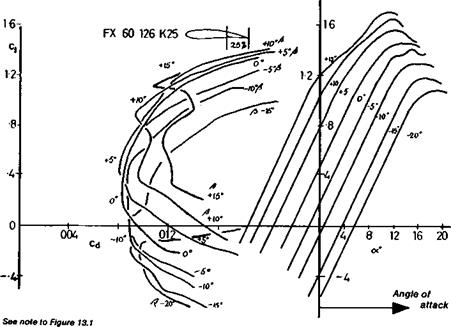FLAPS AND AILERONS
The function of the elevator is to control the angle of attack of the wing. The wing itself may have flaps or variable camber, which can assist, oppose, or even supplant the elevator. In a well-designed model if the wing flaps are lowered, this increases the camber and simultaneously alters the geometric angle of incidence, measured from the flap trailing edge. The increase of camber causes an increase of the nose-down pitching force but, at the same time, the lift coefficient will rise, increasing downwash on the tail, tending to raise the nose. When the model settles down into a new equilibrium, it will be at a lower airspeed, but it may have only a slightly nose down or nose up attitude depending on the precise balance of flap angle, pitching moment and downwash. If, then, the elevator is
|
Fig. 13.2 The effect of hinged control surfaces
|
moved up, the airspeed will fall still further in the normal manner, but because of the greater camber with flaps down, the stall will come at a lower geometric angle of attack. Flap movement in the opposite sense has the reverse effects – q falls, the pitching moment is reduced but so is downwash. Speed rises without much change of attitude. Depression of the elevator will lead to a further increase in airspeed. Some models, particularly control line aerobatic types, have been built with elevators and flaps coupled. The advantage of this system is mainly the quick response of such a model to control movements, allowing ‘square cornered’ looping manoeuvres to be performed. The elevator must be powerful enough to overcome the adverse increased pitching moment as the flaps go down. Then the wing Cl rises very sharply and momentarily the total lift force exceeds the weight of the model, the speed not having had time to fall off. The excess lift accelerates the model in the desired direction and the elevator simultaneously rotates it into the new position. Radio controlled models find similar coupling useful.
As Figure 13.2 shows, the general effects of hinged flaps or ailerons fitted to a cambered wing are almost the same as those of a symmetrical profile similarly fitted. The only important difference is that the cambered zero flap setting has a negative zero lift or ‘absolute zero’ angle of attack. Otherwise, as before, increasing camber raises the lift curve to the left, decreasing camber moves it down to the right The drag curve shift is also as expected. The wind tunnel results given here are again at a Reynolds number too high for any models likely to employ such a cambered profile, but the general principles are not affected.
As shown in Figure 7.8 (Chapter 7) a model in a turn must bank in order that a sideways force can be produced by the wing lift, to balance the outward inertia force against the turn. Banking is accomplished normally by the action of the ailerons aided by the rudder of a model. The operation of ailerons can be understood from Fig. 7.6. As one aileron goes up, the other goes down, creating an imbalance of the lift forces on the wings, and the model rolls. The rolling movement is damped as described in Chapter 5, by the change in angle of attack on the up and down moving wings, so in a steady roll, the damping forces are exactly balanced and equalled by the imbalance caused by the ailerons. To achieve a fast rate of roll, powerful ailerons are required, together with small damping, which implies small wing span with ailerons occupying up to 80% of the trailing edge of the wing. As Figure 13.1 showed, increasing the chord of a control surface increases its effect only slightly, but extending it along the span allows it to change the camber over most of the wing, rather than only near the tips, and this is by far the best way of improving aileron control. Ailerons, however, should not be reduced in chord too far. They work in the area where the boundary layer is thick, and very narrow surfaces, or ‘strip’ ailerons suspended behind the trailing edge proper, may be blanketed and hence ineffective. It is probably best not to extend them all the way into the wing tip vortex, or completely to the wing root












